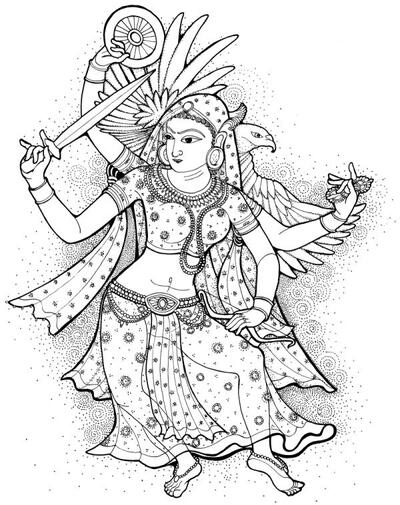The final goddess highlighted in the “Miracles and Devotees” section of A Garland of Forgotten Goddesses is the fascinating Rāṣṭrasenā, whose name is also spelled Rāṣṭraśyenā. She is alternatively visualized as either a woman or a hawk, and her hilltop temple in southern Rajasthan was strategically located so that she can protect the kingdom of Mewar from invading forces with her birds-eye view of the surrounding countryside.
In the wonderful image below, created for the book by Laura Santi, Rāṣṭrasenā is depicted in a pose inspired by the Rajasthani ghoomar dance which originates with the Bhil tribe. Adam Newman, the author of this chapter, lays out in the essay portion the evidence suggesting that Rāṣṭrasenā may have originated as a Bhil goddess who was incorporated into the broader pantheon of Mewar in medieval times.

The passages below are translated from the Sanskrit Ekaliṅgamāhātmya by Adam Newman. The goddess who created Rāṣṭrasenā in this story, Vindhyavāsā/Vindhyavāsinī, is one of the main prototypes of the pan-Indian goddess Durgā.
Then, she set her mind on protecting the empire. Vindhyavāsā then emitted the goddess Rāṣṭrasenā from her own body, after which she installed her there, on the mountain. Delighted at seeing herself in the form of Rāṣṭrasenā, Vindhyavāsinī said these words to her: “O goddess, take fully the form of a hawk and protect the kingdom! Destroy the evil demons—daityas, rākṣasas, piśācas, bhūtas, anḋ pretas—with the thunderbolt (vajra) you hold. While in the form of a hawk it is your duty to protect Medapāta (Mewar) from yoginīs and jṛmbhakas, evil Seizer demons, and others. If some evil people come to this country desiring war, you should destroy them with your spells and powers.”
If the local king and people in Medapāta are to be victorious, then the ruler of these people should worship Rāṣṭrasenā daily. On the eight and fourteenth days of the waxing and waning moons, when the sun passes from one zodiacal sign to another, and on other such transition days, one should worship Rāṣṭrasenā and also women who look like her. One should properly worship all Brahmins in order to please the goddess completely. By doing so Rāṣṭrasenā, delighted, grants wishes to those who worship her. Therefore, one should worship Rāṣṭrasenā with complete devotion in the proper way. One should worship her daily with devotion during the bright half of the second lunar month in Spring. The goddess named Rāṣṭrasenā is the protector of Medapāta. Because of her, the empire will not be destroyed by foreigners or by any other invader.
—A Garland of Forgotten Goddesses, UC Press 2021